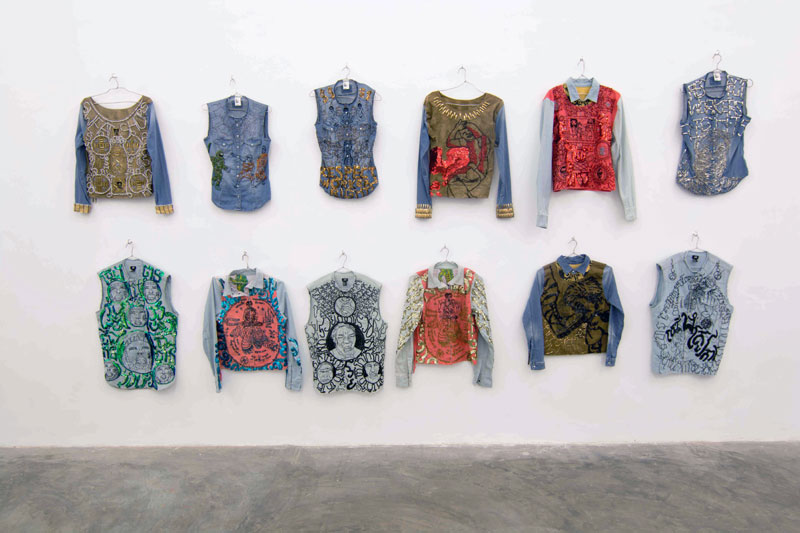It’s a tale of two cities, though less Dickensian and more like postmodern poetry.
The exhibition “Rates of Exchange: Un-Compared” opened last Saturday at the Sa Sa Bassac gallery in Phnom Penh, bringing together six artists from Bangkok and three from the Cambodian capital.

The show is a culmination of a six-monthlong series of symposia and follows a complementary exhibition in Bangkok in December.
It joins together artists from different generations, from renowned Thai artist Pinaree Sanpitak and Cambodia’s Khvay Samnang, to emerging artists like Tith Kanitha.
But rejecting common themes that would invite comparison, the artists were left to their own devices, ranging from sculpture and textile to oil painting and film. The result is a pastiche; each work is both discrete and syllabic while also forming a conversational whole.
Co-curators Roger Nelson and Brian Curtin were compelled to start the project after noting that artistic dialogue between Phnom Penh and Bangkok was scarce.
“Exciting and active horizontal networks between artists and spaces in Cambodia and other neighbouring nations exist, including with Vietnam, [Burma] and elsewhere. But for some reason there hadn’t been that much contact between artists in Bangkok [and] in Phnom Penh,” Mr. Nelson said via email.
“Another [impetus] was simply to experiment—to play with the possibility of a curatorial framework that didn’t impose a curatorial frame on what artists do, and that didn’t attempt or pretend to make totalizing or definitive statements about a nation.”
Some artists showcased existing or ongoing works, but many created new ones for the exhibition. And in the absence of a directive, the new pieces produced surprising connections.
Jakkai Siributr’s work, “Fast Fashion,” was created for the project, drawing on the mass protests that erupted in December 2013 in Phnom Penh when garment workers sought a higher wage.
Taking H&M clothing made in Cambodia, he deconstructed the garments and combined them with tunics called yantra, which are popular in Thailand. The reconstructed pieces bear images from newspaper clippings of the incident, while the Khmer script used was taken from Cambodia’s 1997 Labor Law.
“We have so many cultural, social, religious and political elements in common. And I wanted to explore on these commonalities,” Mr. Jakkai said in an email. “For example, the writing on the Yantra tunic is always written in Khmer because we believe Khmer black magic is the most potent kind. That’s why I’ve used Khmer scripts on my ‘newly constructed’ garments as well.”
Bangkok-based Orawan Arunrak also worked with garments. The 30-year-old multimedia artist embroidered gold filament on a military jacket that belonged to her deceased godfather, who was stationed on the Thai-Cambodian border about 20 years ago, she explains in an email, exposing threads connecting her family and the two countries.
Others took a more participatory approach to their art.
Architect Pen Sereypagna showcases maps of Phnom Penh that he first displayed during the Our City Festival last year. He had invited visitors to write on the maps.
“The idea is to allow people to build the idea of Phnom Penh city, what they want Phnom Penh to look like in the future,” Mr. Sereypagna said. “We try to visualize the ideas because ideas are abstract and invisible.”
The map traveled to the “Rates of Exchange” exhibit in Bangkok and now, back in Phnom Penh, Mr. Sereypagna again solicits contribution: A new map lies on the gallery floor for visitors to inscribe their thoughts on.
Meanwhile, on an opposite wall, a video by Seng Simouy and Sok Chanrado shows Ms. Pinaree’s project “Breast Stupa Cookery,” where the Thai artist creates molds shaped like breasts and asks locals to cook traditional cuisine using that mold. Ms. Pinaree has taken the project as far afield as Japan, France and New Zealand, and now brings it to Phnom Penh.
“Prahok is a food that all Cambodians eat, whatever status or where you are from. It creates a natural link which everybody can relate too,” Ms. Pinaree says of her latest muse, a fermented fish paste, adding that she was interested by its similarity to a Thai concoction, plaa raa.
Mr. Nelson said he appreciates the connections and contrasts born from placing the otherwise disjointed works in one space.
“To compare feels so natural, it can seem like a commonsense way to make sense of the world and especially of places, cultures and artistic practices,” the curator said. “But I am interested also in the idea that comparison is an historical invention, and one that rose to prominence alongside various European academic disciplines—including anthropology and art history—during the modern and thus the colonial eras.
“I would never suggest that this project, or indeed any curatorial project, could ever begin to destabilize that deeply entrenched idea of comparison, or to offer an alternative. But I felt it was important to attempt to play with it, to denaturalize the idea of comparison, at least in this context.”
Without an imposed narrative, the works nevertheless articulate an emerging sense of shared—and conflicting—identities among Southeast Asian artists.
“As a region, we are so diverse but at the same time if you look closely at our neighbors, we also share so many similar things,” Mr. Jakkai said.
“And anyhow, to go back 700-800 years, there were no boundaries that dictated who we were and who we were not. And so it is very important for this kind of exchange as we move forward as a region.”



